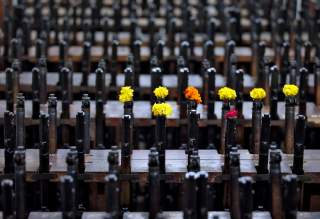A Gun Cabinet Or Gun Safe? What Is Best to Store Your Guns?
We evaluate.
The choice between a gun safe and a gun cabinet may seem simple at first, but it can get complex quickly. Your choice is influenced primarily by two things, your budget, and your level of paranoia. Just remember, no matter how old, rusted or plain worn out your gun is, there is always somebody willing to steal it.
My dad had an ancient revolver that would have been a museum piece had it not been falling apart. Somebody stole it.
Maybe you just need a small gun safe to safeguard a couple of handguns. The good news is that it is cheap and easy to carry. The bad news is that if it is easy for you to carry, it is easy for a burglar to carry. My younger brother came home from a trip and found his front door forced open and his portable gun safe gone.
The decision may simply be based on the size of your income. If you are on a limited budget, a gun cabinet is cheaper, and if you are good with your hands, you can build it yourself. My dad built a beautiful cabinet with a hammer, a box of cabinet nails, a lock and hinges, a miter saw and some lumber. He even put a framed glass door on it.
A lock on the door of a gun cabinet may not keep out a determined burglar but it will keep the grubby little hands of curious children from reaching your firearms.
The complexity of the decision between a gun cabinet and a gun safe is compounded by the fact the there are literally hundreds of different products to choose from.
Top-of-the-line gun safes tend to be as solid as a bank vault, but the sturdier ones are also more expensive. At the risk of being redundant, the lower you go in price, the weaker the product.
Example: That $98 eight-gun safe advertised on the Internet is described by the manufacturer as having a “welded, steel box construction” and a “3-point locking system with double-bitted, key coded lock.” The manufacturer uses words like “sturdy” and “solid.”
Consumers who bought it posted words like “flimsy,” and “barely adequate,” and described it as being “too small for eight guns” and having “walls the thickness of an average filing cabinet.”
Higher priced gun safes tend to be both heavy and heavy-duty. If the safe you are looking at looks like it could be opened with a claw hammer, or if it is light enough for you to carry up the stairs without assistance — keep looking.
Evenly a barely adequate gun safe should be heavy enough that the delivery man works up a sweat. If you are planning to put one in the upstairs master bedroom, you should find some serious muscle to help. Remember, if it is too heavy for you to move without big neighbors working for beer, it is too heavy for a burglar to move.
People with gun safes tend to consider them a good investment. In addition to guns, you can put your valuables in there and keep them safe from fire, flood, and theft.
Join 70,000 Readers For Our Weekly Discounts
GET MY DISCOUNTS
Table of Contents
ADVANTAGES OF A GUN SAFE
-
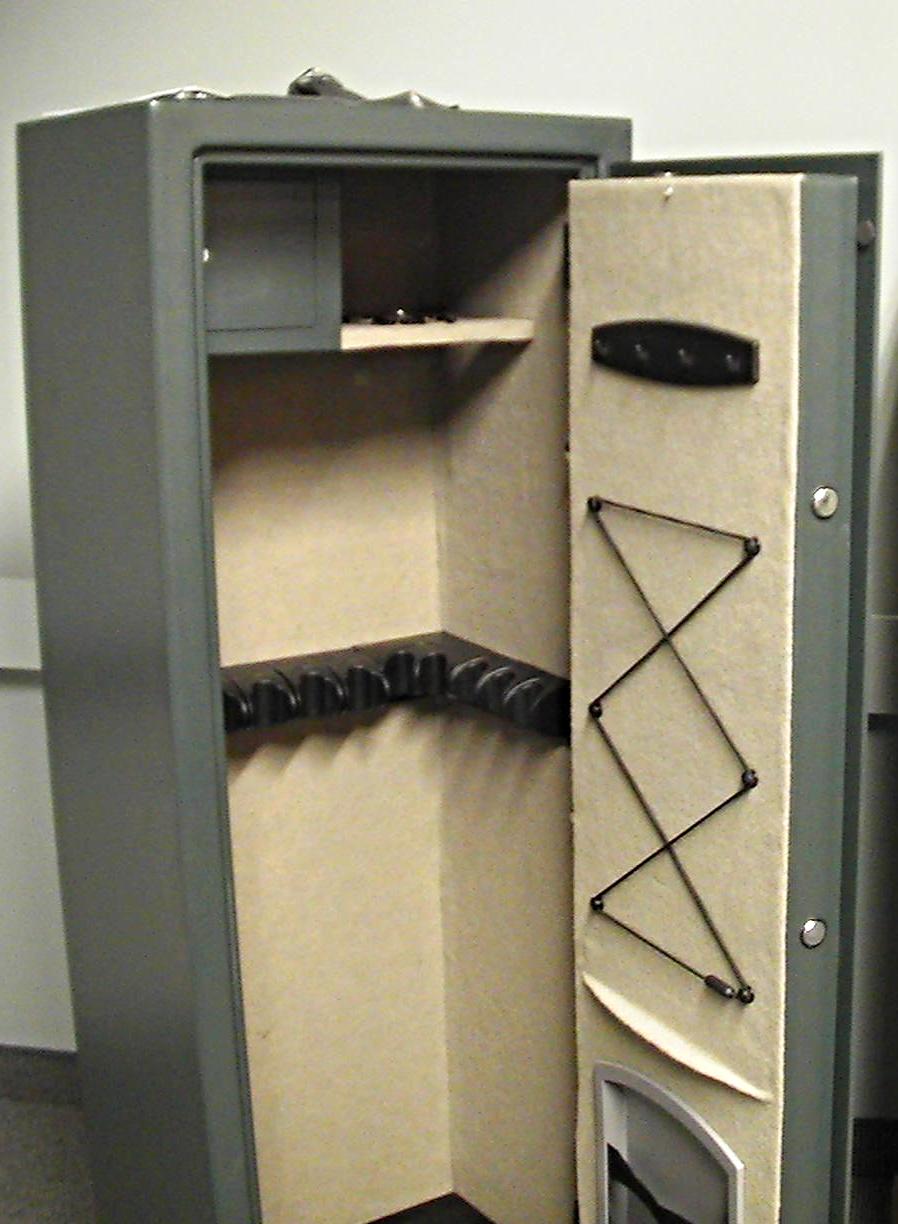
Thick steel walls capable of standing up to a sustained assault.
-
Protects contents from fire, theft, and most water damage.
-
Too heavy for a thief to move.
DISADVANTAGES OF A GUN SAFE
-
Visual — very few gun safes will match your décor.
-
Expensive — quality depends on price
-
A good quality gun safe is too heavy to be moved by one person.
ADVANTAGES OF A GUN CABINET
-
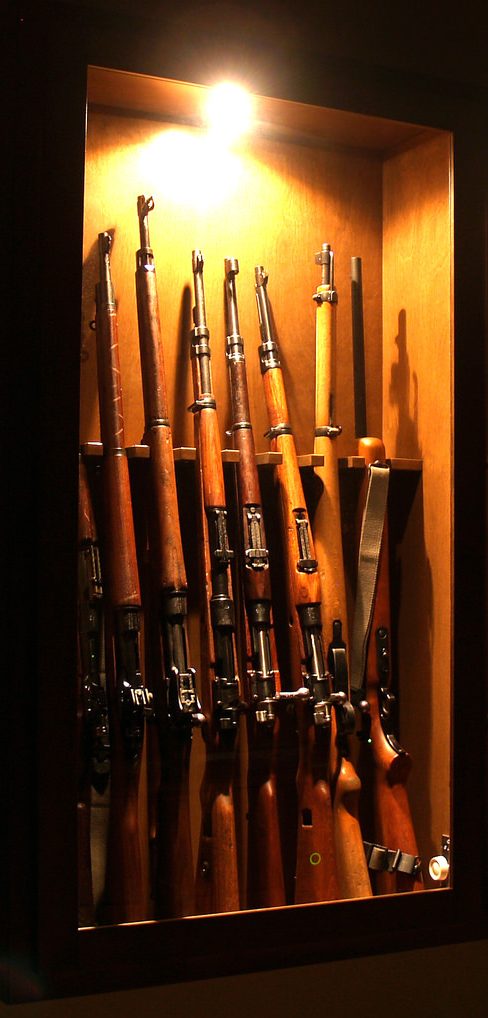
Visual — most gun cabinets are visually pleasing and display your weapons collection nicely.
-
Lightweight — can usually be moved by one person.
-
Affordable — can be chosen to fit your budget. Can be built from scratch or even assembled from a kit.
DISADVANTAGES OF A GUN CABINET
-
Lack of security — easy to break into
-
Zero protection in the event of fire or flood.
RECOMMENDATIONS:
GUN SAFES
We start with gun safes simply because there is just something about a big hunk of steel that makes me feel all happy inside.
Supplier — Any establishment calling themselves gun safe experts, gun safe authorities, or claiming to know “everything” about gun safes should be avoided like a terrible disease.
Wall thickness — Thickness of steel is determined by gauge. The lower the number, the thicker the steel. Look for 11-gauge or lower.
Door Thickness — As silly as it sounds, most gun safe doors are thinner than the walls. As with the walls, thicker is better. Look for a one-quarter inch to a one-half inch steel plate. Anything thinner is flimsy, anything thicker tends to overtax the hinges.
Rating — Look for an Underwriter Laboratory ratings of RSC (Residential Security Container).
Size — There is an old formula used by bird hunters to figure out how many shotgun shells to carry into the field: “Decide how many you think you can shoot and triple that number.”
The recommendation on a gun safe is to buy double, or even triple, the size you think you need. Trust me on this one. Gun safes are like kitchen cabinets, they fill up fast.
Some gun safes list interior dimensions while others list interior “cubic feet.” To compare apples to apples, use this formula:
Multiply the height, width, and depth of the interior of the gun safe and divide by 1728. Height x Width x Depth / 1728 = cubic feet.
Example: 75” x 30” x 24” = 54,000 cubic inches / 1728 = 31.25 cubic feet
Weight — Go for heavy. In general, heavier means sturdier construction.
Hinges — A gun safe should always have internal hinges. External hinges can be chiseled off to remove the door.
Fire Rating — Buy the highest fire rating you can afford, starting with one hour. For documents or papers easily damaged by fire, consider a small certified fire box placed inside the gun safe.
 For electronic media, such as CDs, DVDs, and USB thumb drives, as well as video and audio cassette tapes and photographs, consider a data/media safe, which will keep the inside temperature below 135 degrees and the humidity below 85%, and can be placed inside of the larger gun safe.
For electronic media, such as CDs, DVDs, and USB thumb drives, as well as video and audio cassette tapes and photographs, consider a data/media safe, which will keep the inside temperature below 135 degrees and the humidity below 85%, and can be placed inside of the larger gun safe.
Also, remember that the higher the fire rating, the better the protection against flooding. The door fire seals do double duty as water seals. Be careful here, a “fire-resistant-only” gun safe is a thin-walled safe lined with fire-resistant composite material.
Choose a thick-walled protective safe that is also fire resistant. The words to look for are “fire resistant.” If the supplier uses the term “fireproof,” walk away. There is no such thing as a truly fireproof safe.
Placement — Place your gun safe where it is convenient to use and there is enough light for you to read the lock. If you must place it in a dark place, a stick on battery-operated light is sold as an after market accessory.
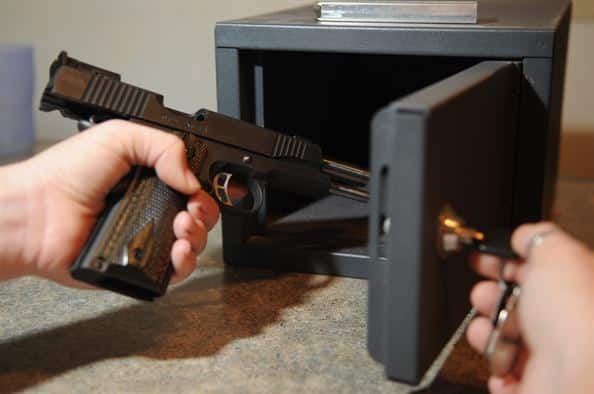
Lock — There are excellent locks of both dial and electronic design. Overall, manual dial locks tend to last longer and have fewer problems. For preppers worried about an Electro-Magnetic Pulse (EMP), manual dial locks are recommended, but there are “hardened” electronic locks resistant to EMPs available.
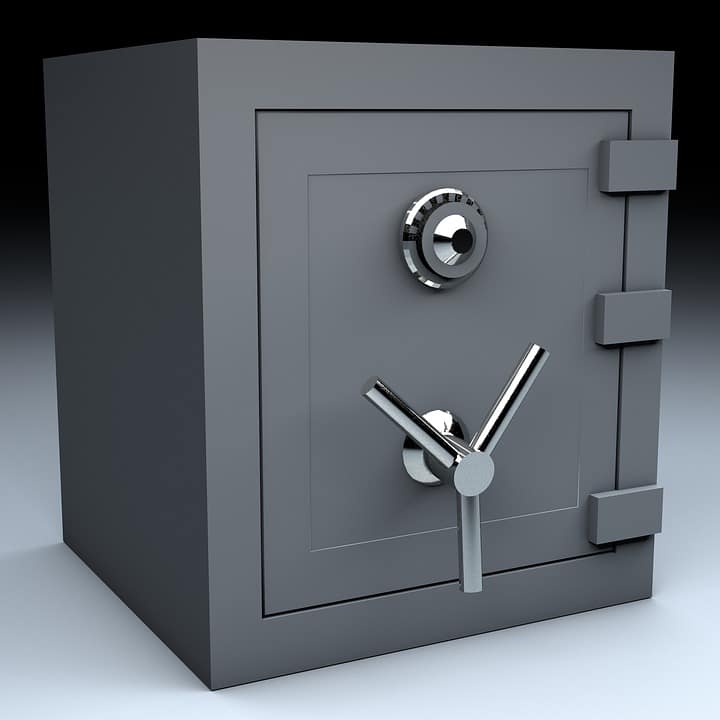 Mechanical locks require maintenance from a lock technician every few years. Always set the combination to something a thief cannot guess. Do not use your birthday or phone number.
Mechanical locks require maintenance from a lock technician every few years. Always set the combination to something a thief cannot guess. Do not use your birthday or phone number.
Electronic locks are sealed by the manufacturer and, except for changing the battery, never need maintenance. The battery should be changed regularly. A low battery may still work, but over time, it can damage solid-state electronic components.
For business locations such as sporting goods stores, if multiple people need access to the gun safe, certain electronic locks can be programmed with multiple combinations. If one person leaves and should no longer have access, you can disable his code without affecting anyone else.
Redundant locks give you the best of both worlds. They consist of both a mechanical lock and an electronic lock built together. You get the convenience of an electronic lock, but if it ever fails, you can still open the safe using the dial.
Two-man lock— a two-man lock is used for added security. It requires two different entry codes, or in the case of mechanical dial locks, the same door has two separate locks, so that two individuals are required to open the safe.
Panic Mode — This feature is connected to your alarm system and gives you two combinations. One simply opens the gun safe. The other opens the gun safe — and uses your alarm system to inform the police there is a robbery in progress.

